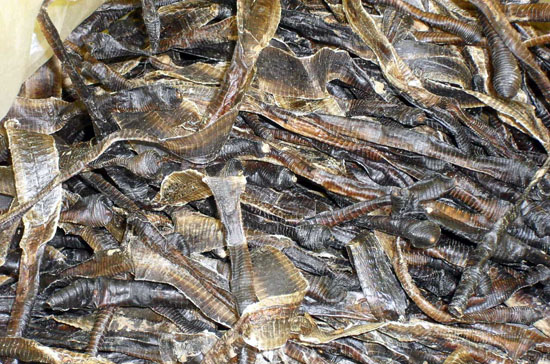Distribution:
Guangdong, Guangxi, Fujian, and throughout China
Properties (characteristics):
Salty, cold.
Channels (meridians) entered:
Stomach, bladder, liver, lung, spleen.
Medical functions:
anti-histamine and calming asthma
expand bronchi
antipyretic
sedative and anti-convulsion
lower blood pressure
diuretic effect
Actions & Indications:
High fever and spasms, Infantile Convulsion, painful joints due to arthritis and paralysis, heat type of wheezing, Asthma, (single item of ground up di long can be used ), injuries and pain, Edema and difficulty in urination.
Chemical ingredients:
Lumbrofefbrine, lumbritin, terrestro-lumbrolysin, hypoxanthine, xanthine, adenine, guanine, choline, guanidine, ornithine, lysine, serine, proline, glycine, cystine, valine, phenylalanine, tryptophan, neutral lipids, cholesterol, free fatty acids, triglycerides, complex lipids, phosphatidylcholine, phosphatidyl ethanolamine, phosphatidylserine, dehydrogenase isoenzyme, esterase isoenzyme.
Dosage:
For decoction: 4 g ~12 g. In powder form: 2 g to 4 g. Concentrated extract: 0.5 ~ 2 g.
Samples of formulae:
Wheezing cough due to lung heat: di long, Herba Ephedrae (Mahuang), xing ren, Radix Scutellariae (Huangqin).
Lower back and leg pain due to physical injuries: di long, Radix Angelicae Sinensis (Danggui), Cortex Cinnamomi (Rougui)
hot painful urinary dysfunction with stones, urine retention, or edema: di long, niu xi, dong kui zi, Herba L ysimachiae (Jinqiancao).
hypertension with liver yang ascending: di long, dan shen, ci shi (magnetitum)
Cautions:
Large amount can be toxic. Symptoms include headache, dizziness, palpitation, difficulty in breathing, and initially the blood pressure goes up and then goes down, sometimes the digestive tract may show bleeding.


![Diseases, Symptoms, tcm, [tcmwindow.com]](/uploadFile/adImg/2015/11/11/f5cbfcc0-4df5-4646-9b9a-f316651a0199.jpg)





